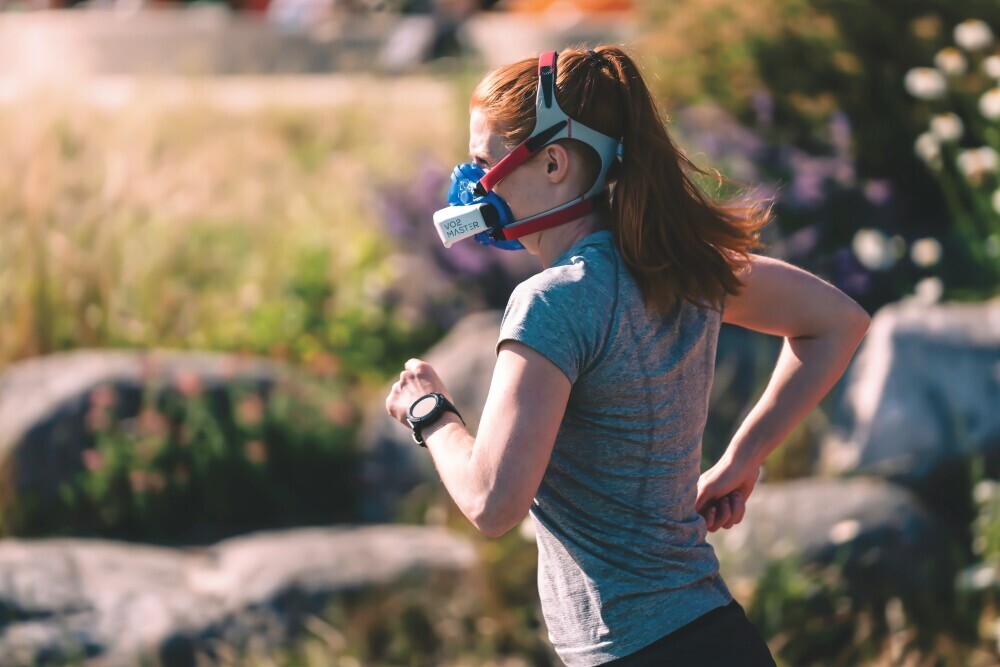Of the many ways to get into and stay fit, running is one the most effective. However, many beginner runners often find themselves gasping for air mid-run. Breathing issues can feel frustrating and stop or limit the enjoyment of a run. In my own case, I have episodes of exercise induced asthma. So, drawing on my clinical background, I have spent years researching, testing and practicing different techniques to help improve breathing while running. In this article I will share with you what I have learned about the physiology of respiration during exercise with some useful insights and what ultimately works.

Understanding Why Breathing Can Be a Challenge When Running
Several factors can contribute to struggling to breathe. Often it starts with how our bodies are conditioned, how we breathe, and even how our posture supports breathing. When you run, your body demands more oxygen. If your breathing technique isn’t quite right, you may experience feelings of fatigue and struggling for more air.
One reason you might struggle is shallow breathing instead of taking full, deep breaths. Shallow breaths only use the upper part of your lungs, meaning you’re not maximizing your full lung capacity and oxygen intake. Additionally, if your posture isn’t quite right – for example, if you’re leaning too far forward – this can compress your lungs and make breathing less efficient. Many runners have reported improvements simply after adjusting their posture.
Add to these considerations the environment where you run. Running in areas with poor air quality or in cold weather can affect your respiratory function.
Finally, training yourself with breathing techniques to maximize your natural capacity. All of these elements impact breathing during exercise.
Building Lung Capacity and Improving Breathing Efficiency
Increasing lung capacity cannot be accomplished in a day or two, but there are methods you can use to gradually improve. An important part of this is practicing diaphragmatic breathing. This method involves using your diaphragm, a muscle located at the base of your lungs, to help you breathe more deeply.
Diaphragmatic breathing allows your lungs to fill more completely. The basic idea is to focus on breathing in a way that your stomach rises and falls, rather than your chest and shoulders moving. This encourages fuller breaths and helps ensure that oxygen reaches the lower parts of your lungs.
To practice diaphragmatic breathing, you might try sitting or lying down and placing a hand on your stomach. Inhale slowly so your hand rises, and exhale and notice it lower. By training your lungs a few minutes every day you can significantly boost your comfort during runs and improve your stamina.
Breathing Techniques to Improve Your Running Performance
Once you understand the basic mechanics of breathing and have started building lung capacity, it’s useful to adopt specific breathing techniques that can be used while you are actually running. Rhythmic breathing is one method that can help coordinate your breathing with your running pace.
Rhythmic breathing, also called synchronized breathing, means finding a steady pattern that syncs your inhales and exhales with your steps. For example, some runners find success with a 3:2 pattern. This means inhaling for three steps and exhaling for two. I first learned to practice this technique in the military, and it works extremely well. It also reduces the likelihood of side stitches.
Another important tip is to breathe in through your nose and out through your mouth. This technique helps filter air before it enters your lungs and allows you to control the airflow better. Inhaling through your nose can help warm and humidify the air as it passes over the nasal concha, making it easier on your lungs and airways.
Exhaling through pursed lips lets you release air with more pressure and slowly, which can be particularly helpful when you’re exerting more energy. Exhaling through pursed lips helps to slow exhalation keeping breath inflating the lungs slightly longer maximizing oxygen exchange. The idea is to increase the oxygen in the blood circulating to the muscles.

Combining these two techniques – diaphragmatic and rhythmic breathing – can yield excellent results. Paying attention to your body and consciously practicing these methods during training sessions can gradually lead to improved performance. Over time, you may find that your breathing becomes almost automatic and more efficient.
Practical Advice: Addressing Common Breathing Challenges
Despite best efforts in training and technique, many beginners continue to struggle with their breathing. There can be several contributing factors, and here are a few practical solutions to help manage these challenges:
- Monitor Your Posture: When you run, try to keep your upper body relaxed and your shoulders low. Good posture allows your lungs more space to expand and function effectively.
- Warm Up Properly: A proper warm-up gets your respiratory system ready for the increased demand. Spend five to ten minutes performing light exercises before you hit your running pace.
- Practice Breathing Drills: Incorporate specific breathing drills into your training sessions. Exercises like timed inhales and exhales can help train and condition your respiratory system.
- Stay Hydrated: Water plays a key role in maintaining clear airways. Ensuring you stay well-hydrated can reduce the feeling of constriction in your throat and lungs during runs.
- Adjust Your Pace: If you are feeling overly taxed, it might help to slow down initially until your breathing can catch up with your body’s oxygen needs. Over time, you’ll build endurance and your breathing should improve.
Putting It All Together: A Practical Breathing Routine for Runners
If you are looking to integrate these techniques into your routine, here is a simple plan to follow. Start by dedicating a few minutes at the beginning of your workout to diaphragmatic breathing. Sit or lie down with one hand on your stomach and take slow, deep breaths, feeling your stomach rise and fall.
Next, during your run, focus on establishing a rhythmic breathing pattern. Experiment with different ratios until you find one that feels comfortable. Many runners start with a 3:2 pattern where you take three steps while inhaling and two while exhaling.
A good warm-up is also important. Spend time doing light jogging and stretching before you commit to your full run. This primes your respiratory system and reduces the shock of sudden exertion.
As you cool down, take a few minutes to walk slowly and focus on deep, renewed breaths. This cool down can help clear any residual tension and restore your breathing to your resting and calm state.
Throughout your training, keep a mental note of any changes. You might find that certain techniques work better under specific conditions. If you are someone who struggles with breathing in cold weather, warming up indoors and/or wearing a balaclava or other face mask could help. Alternatively, if you learn that your breathing improves when you slow down just a bit, consider adjusting your pace as part of your strategy.

Additional Tips and Tricks for Better Breathing During Runs
In addition to the main techniques discussed, there are some extra tips that can contribute to improved breathing efficiency. Maintaining a consistent training routine not only builds endurance for your heart and muscles but also gradually improves your breathing capacity.
Focusing on relaxation techniques before a run, such as deep stretching or listening to calming music, this can ease muscle tension and make each breath feel smoother. Monitoring your environment and choosing times when air warmer or cooler and dryer or more humid can also have a significant impact.
Keeping track of your progress is another practical way to maximize what works best for you. Note what techniques you used during each run, how you felt before and after, and any improvements in endurance or comfort. This reflective practice can help you tailor your training to your body’s responses and ensure that over time you are consistently improving your performance.
Wrapping Up: The Benefits of Improved Breathing While Running endurance.
Learning to breathe better when running not only helps you perform at your best but also makes the experience more enjoyable. Improved breathing can reduce fatigue, prevent discomfort like side stitches, and give you more energy to push further during a run. With practice and mindfulness, the right techniques for you become second nature, leading to a smoother, more efficient running experience.


This is a highly informative and practical guide for any runner looking to improve their breathing and overall performance. The detailed breakdown of the physiology behind breathing challenges during running is especially valuable, as it helps readers understand not just what to do, but why it works. Your emphasis on diaphragmatic breathing and rhythmic patterns is excellent—these are two of the most effective tools for better breath control and stamina. I also appreciated the practical tips on posture, warm-ups, and adapting to environmental conditions, which are often overlooked but make a big difference. As someone who occasionally struggles with breathlessness during runs, this article is both reassuring and empowering. It offers a realistic path to improvement without promising overnight results. Incorporating these techniques into a regular training routine feels not only manageable but motivating. Thanks for sharing such a well-researched and experience-driven perspective!
Hi Andre,
I am really happy that you mention you found my article reassuring and empowering. One of my primary goals is to encourage people to stay committed to their fitness. Knowledge and discipline to act on that knowledge equals power. Having the methods to solve difficulty when it arises give people the tools they need to keep at it and continue forward.
I have been thinking about a series of articles on the topic of exercise physiology. I wondered if people would find that topic interesting enough. Your comments encourage me that maybe that is an area for more content.
This was a great read. I’ve definitely struggled with breathing while running, especially when I first started. Diaphragmatic breathing and pacing my breaths to my steps made a huge difference for me over time. I also found that focusing on posture and doing a proper warm-up helped reduce that early-run breathlessness. It’s amazing how much more enjoyable running becomes once you get your breathing dialed in. Thanks for sharing these tips!
Shawn
Hi Shawn,
Running for me is definitely more enjoyable as I never run out of breath. Now when I run, I let my mind wander as my pace, stride and breathing are basically on autopilot. Developing good habitual breathing technique early on is the key to a lifetime of running and healthy fitness.
Thanks for reading my article.